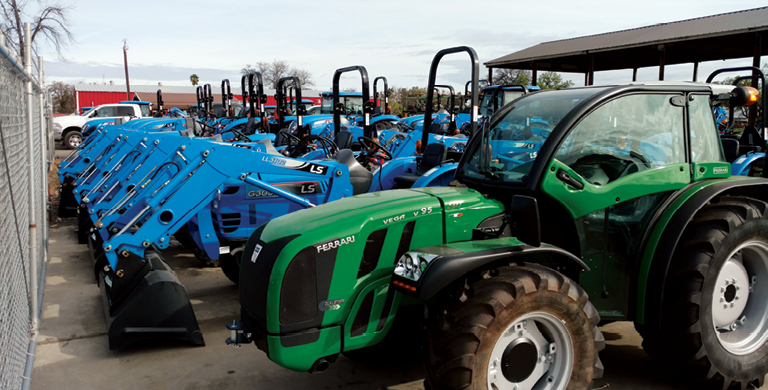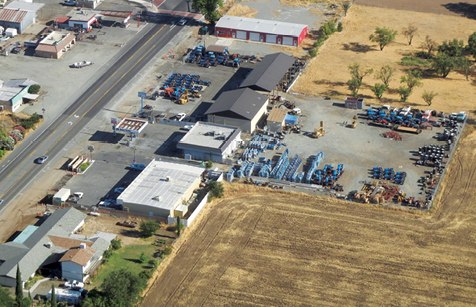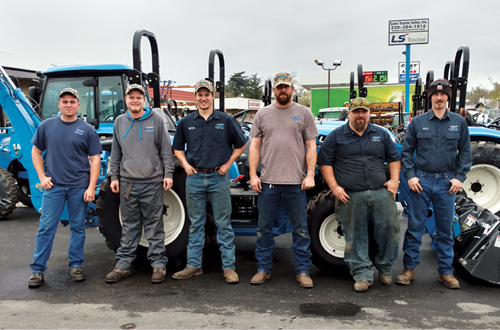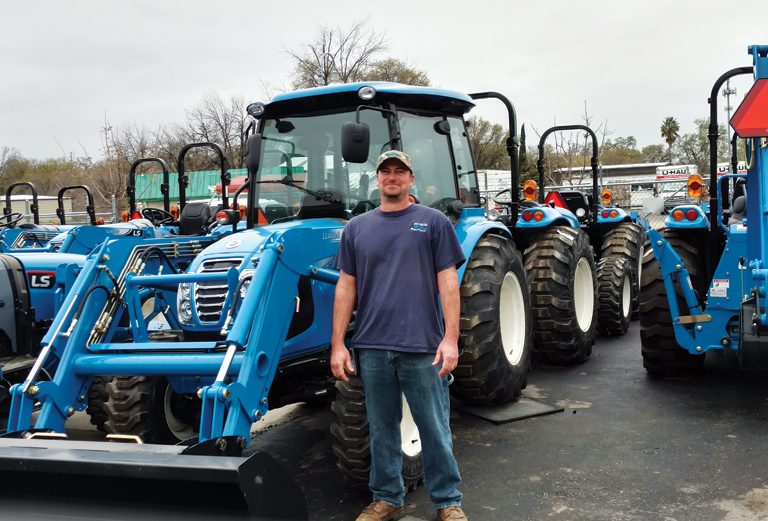Pictured Above: Mike Lane started Lane Tractor Sales 16 years ago in Los Molinos, Calif., an area with diverse agriculture. The dealership now also serves as a distribution hub for LS Tractors.
Mike Lane started his dealership 16 years ago and now serves as the West Coast distribution hub for LS Tractors. He says he’s built his dealership, Lane Tractor Sales of Los Molinos, Calif., by offering a large inventory of price-competitive and reliable equipment — and making the most of opportunities.
“There is so much opportunity in my area, but there’s not a huge mark-up on tractors. I work on being a volume dealer. They don’t do us any good sitting on the lot,” Lane says.
Supporting volume means having the space for inventory and this is one way Lane has made the most of opportunities that have come his way. For instance, he started with a 2-acre location and was able to purchase adjacent land. He now owns 20 acres, currently displaying tractors on 6 of those acres.
Choosing Lines
In the early days of his dealership, Lane carried the TYM and Montana tractor lines. When the Montana brand ceased operations, he transitioned to LS Tractors, the company that manufactured Montana tractors.
Brand awareness was an issue when he first started offering the line, but that has since changed as sales have grown.
“Customers would see my sign and think Lane Tractors was the brand,” he says. “I would tell them that this was the manufacturer for the Montana tractors I carried and that LS was part of the LG company, which makes consumer electronics,” he says.
Lane Tractor Sales
Founded: 2000
Location: Los Molinos, Calif.
Employees: 9
Lines: LS Tractors, Taylor Pittsburgh, Braber, Ferrari Tractors
“Every year, fewer and fewer would ask about the brand. Now, I don’t have to convince them since LS has been expanding so much. Before, 95% of the customers didn’t know about LS and 5% did, but now that’s reversed,” Lane says.
He says customers know that many manufacturers build some or all of their equipment outside the U.S., which has also contributed to a greater acceptance.
Being Price Competitive
There is competition from dealers carrying major manufacturers in his area, but he says the combination of price, tractor features and quality helps him compete. “You always have to look at price. Certain lines of tractors are so expensive. With LS, you’re not getting the cheapest tractor, but the best value. I’m able to beat my competitors on price in every model,” he says.
The dealership is located less than 200 miles from San Francisco and Lane says his rural lifestyle customer base grows and shrinks based on how the economy is affecting retirees. “Depending on the stock market, we have a lot of retirees moving up from the Bay area who buy 5 acres and need equipment. When housing is expensive here, many move to Nevada instead.”
He says the good economy has led to other sales. “Some have lived here their whole lives and are tired of their old 8N tractors.”

Mike Lane of Lane Tractor Sales says the LS Tractor line has helped him sell to both rural lifestyle and farm customers. The dealership is adding the Ferrari line to target orchard and vineyard owners in the area.
Lane says his large inventory of tractors as well as parts helps him win sales. “I have the largest inventory in northern California even though I have just one location. And I can’t properly service my customer if I don’t have the parts in inventory,” he says.
Adding Distribution Center
The dealership’s role as the West Coast distribution hub provides additional revenue. Factors such as his location in California and the expansion plans he already had under way, helped him earn the partnership in 2010. “LS needed a distribution center out here and we’re close to the port of Oakland, making the freight cheaper. We’re also centrally located for shipments throughout California and to states like Arizona and Washington,” Lane says.
Dealer Takeaways
• Opportunities for growth could come from an expansion of your physical location, the lines you carry or new business arrangements. Be open to new ideas.
• Know where you stand on price against competing dealers in your area.
• Continually analyze the performance of the brands you sell and be willing to make changes.
He was also already in the process of building a facility that he could utilize for assembly and storage. His dealership now has two buildings, totaling 7,000 square feet, plus outside storage. “I was in the middle of building and now I wish I had built it twice as big,” he says.
Lane’s persistence in pursuing the partnership also played a role. “I offered my services repeatedly,” he says.
His staff includes a general manager, assembly manager, two service technicians, a shop foreman,who also works as a service tech, and three other employees who support the distribution center and are training to be technicians. “We’ve been growing every year. We finished our sixth full year of being a distribution center and we’ve seen steady growth of 25-30% on average every year,” Lane says.
Lane is able to balance the demands of serving his rural lifestyle customers as well as his dealer customers. “We can handle a slow couple of months on the retail side because we’re busy assembling LS tractors,” he says. Assembly duties generally include adding steering wheels, tires, roll-over bars and front-end loaders.
Tracking Minimum Wage Increases
Fourteen states began the New Year with higher minimum wages. Of those, 12 states increased their rates through legislation passed in the 2014 or 2015 sessions, while two states automatically increased their rates based on the cost of living, according to the National Conference of State Legislatures.
Bills in the House and Senate, both referred to as the Raise the Wage Act, were introduced last year and are now in committee review. This would increase the federal minimum wage to $12 by 2020.
John Schmeiser, CEO of the Western Equipment Dealers Assn., says the association’s member dealers have expressed concern about the effect these proposed changes could have on their businesses.
“The concern we have is that the wage jumps, like those proposed in states like California and Washington, are very aggressive leaps,” he says.
“What we typically see at the federal or state level is usually a moderate increase. The wage increases seem to be driven by a social agenda without any consideration to how it could negatively affect employers,” Schmeiser says.
“We believe minimum wage increases should be reasonable and applicable to the market conditions,” he says. “Excessive increases go right to the bottom line and increase costs for artificial reasons.”

Schmeiser says such increases may mean dealers have to adjust the level of benefits they offer employees to assume the extra wage costs. Similar to the effects of the Affordable Care Act, he says some dealers may choose not to hire additional employees. Schmeiser also says it can affect employee relations overall. For instance, those who are currently being paid above the minimum wage may now expect a similar wage increase.
“We need dealers to stand up and support their association’s lobbying efforts on this important issue. They need to be involved and testify when hearings are being held,” Schmeiser says.
Adding Lines
Lane is expanding the manufacturers he offers to take advantage of new opportunities. “I have a specific need to offer a true orchard tractor. Orchards are a huge business around here and only a couple of manufacturers provide smaller sized tractors with high horsepower.”

The footprint for Lane Tractor Sales of Los Molinos, Calif., includes two warehouse, assembly and shop facilities totaling 7,000 square feet (facilities in the photo with the darker roof) as well as the adjacent retail facility. A recent expansion included the acquisition of 16 acres behind the dealership.
He will soon begin offering and distributing the Italian-made Ferrari tractors. The tractors, with models ranging from 40-95 horsepower, are known for their low center of gravity and safer operating conditions on slopes. “This is a product that no one else in California has. You always have to look at price. If you bring in a tractor that’s not familiar, you better be price competitive,” he says.
That price sensitivity led to him changing the attachment lines he carries. “For a long time, I dealt only with Bush Hog, but when Alamo bought Bush Hog, the prices went up and it was harder for me to compete. I had to expand,” he says.
He now carries attachments from Taylor Pittsburgh and Braber along with other lines through Gearmore. The lines fit his price-competitiveness goal and again he focuses on having a large inventory to win business. He stocks close to 40 different kinds of tractor implements, including box scrapers, tillers, rotary cutters, fertilizer spreaders, discs and snow blowers.
Coping with Regulations
Lane Tractor’s location in northern California offers unique advantages and disadvantages related to the area’s agricultural diversity, rural lifestyle segment, state regulations and the ongoing drought.

The team at Lane Tractor Sales supports the dealership as well as assembly and distribution responsibilities for LS Tractors. From left to right: Austin Mallon, Johnathon Wright, Trevor Gipson, Rob Anderson, Kris Atkins and Hillie Adema.
“A lot of manufacturers want to be in this market because of all the ag businesses here — tree nuts, fruits, orchards and we’re even big in rice production. California agriculture is dependent on irrigation. We’re lucky in northern California in that most of our irrigation districts have been grandfathered in,” he says.
However, regulations related to water use do influence the timing of sales. “From June through September in many areas, you’re not supposed to do any kind of mowing because of fire hazards. It does get people more interested in buying in the winter and spring so we promote the benefit of getting their properties fire safe.”
Lane says he also is watching regulations related to the minimum wage. California is among a group of states whose minimum wage is higher than the federal rate. It’s currently at $10 an hour, but there is a ballot initiative to be voted on later this year that could raise the minimum wage to $15 an hour.
He also says California’s OSHA regulations are among the strictest in the country. “Regulations have exploded in California in the last 20 years. It gets difficult to maintain a certain amount of profit because of the expenses involved. It’s taken a toll on a lot of businesses throughout the state,” Lane says.
Winning Business
The top seller for Lane’s rural customers is LS Tractor’s XR Series 35-55 horsepower models. Lane says customers like the smaller chassis and the power of 4WD. The higher horsepower XG and XJ models are popular among his farm customers.
A good share, about 40%, pay for the tractors outright while the other 60% seek financing.
“We had a higher percentage of customers seeking financing about 10 years ago than we do now,” Lane says. He attributes this to his farm customers and retirees who have more cash on hand these days and who don’t require as much financing from him.
The dealership offers financing through DLL Group.
“We’ve seen steady growth of 25-30% on average every year …”
Lane says word of mouth referrals and satisfied customers are most critical in earning new business and repeat business. His busy location on California Highway 99 East helps with visibility for the dealership.
He says TV ads have been more beneficial in promoting the dealership than radio ads. He also says billboards and print ads have been effective.
“My customer demographic still picks up print publications to read and many don’t even turn on a computer,” Lane says.
He says many of his customers have been with him since the early days of his dealership.
Planning Expansion
The next phase of growth for the dealership is preparing 4 more acres for outside tractor and attachment storage. The team is preparing the site and adding gravel along with fencing and a security system.
“We might expand into a satellite location along the coast. We’re also trying to build up the LS dealer network. I talk to a lot of potential dealers and am more than willing to help out and answer questions,” he says.
Regardless of whether he’s serving his own customers or other dealers, speed to delivery and 100% customer satisfaction are his goals. They try to deliver tractors to retail customers the same day of purchase or shortly thereafter and have similar shipping goals for dealers.
“If you don’t take care of your customers, someone else will. We strive to satisfy every customer 100%. That may be impossible, but that’s our goal.” Lane adds, “You have to provide a good value, no matter what you’re selling.”






Post a comment
Report Abusive Comment